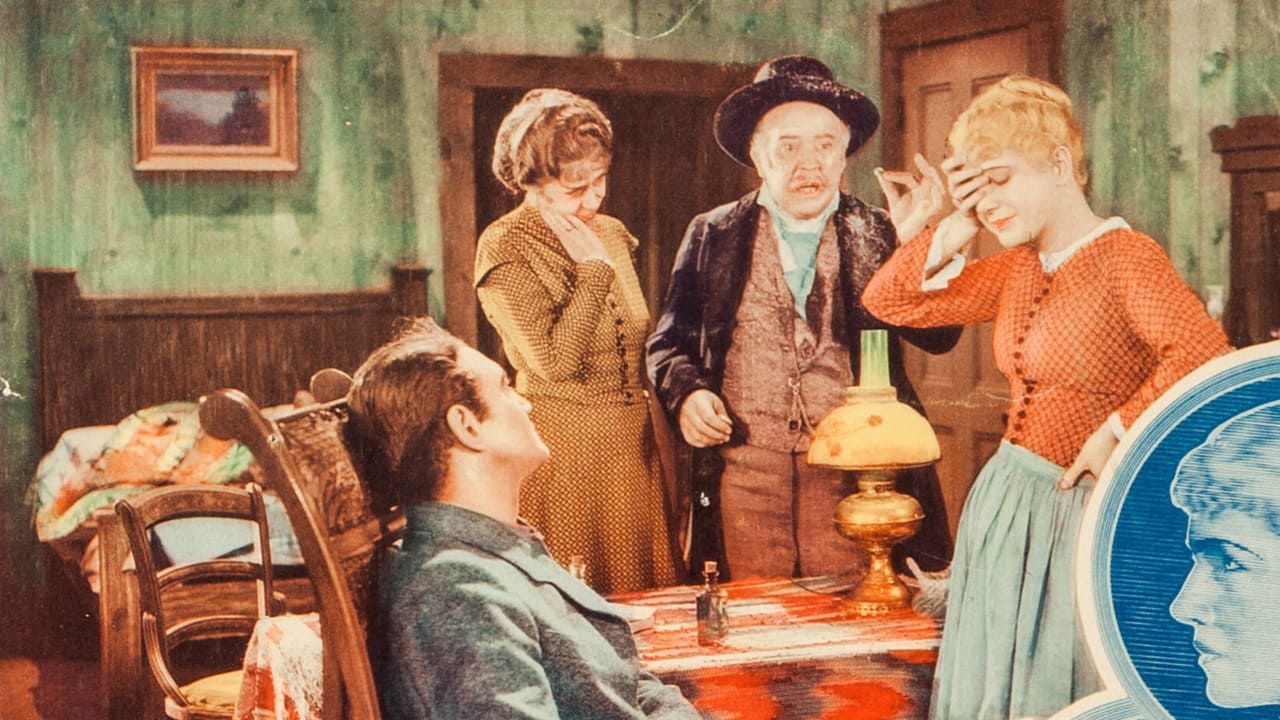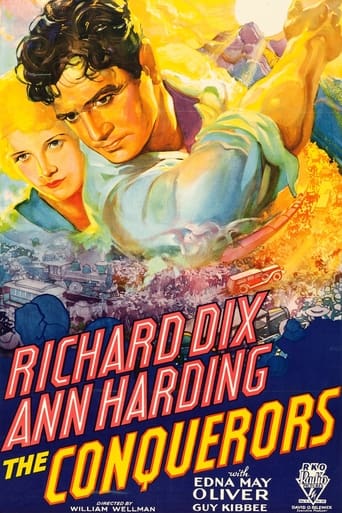

When I first started watching this film I thought it was going to just be a rehash of CIMARRON. After all, just two years earlier Richard Dix starred in this Oscar winning film and now that he was back in an epic Western again, I just assumed it was going to be pretty much the same thing. However, despite some similarities, THE CONQUERORS turned out to be a good film in its own right. Instead of being like CIMARRON, the film turned out to be a lot more like CAVALCADE--an Oscar winning film that was to appear a year after THE CONQUERORS. Like CAVALCADE, the film follows two families through roughly the same time period--showing their many ups and downs--deaths, war as well as great wealth. The biggest difference being that CAVALCADE was set in Britain and THE CONQUERORS was set in the American West.The film begins with Richard Dix and Ann Harding wanting to get married. However, Harding's father refuses to allow the marriage to Dix--after all, Harding's family is very wealthy and Dix has few prospects. However, when the stock market crashes and Harding's family is ruined, they are able to marry and travel westward. On the way, in Nebraska, Dix is nearly killed by bandits and they end up making their home in a town on the prairie.The rest of the film consists of the families many ups and downs. Despite many hard knocks, the family's spirit is never crushed and they persevere. In this sense, they are archetypes of the new American spirit and are meant to show the audience that despite many problems, there is light at the end of the tunnel--an obvious metaphor for the Depression. In other words, things may now look bleak in 1932, but like this family we will make it.The bleakest periods were surprisingly moving and very, very vivid. In fact, because the film was made during the so-called "Pre-Code" era, the intensity of some of the violence was pretty surprising. For example, there is an impromptu mass hanging that is among the most realistic I have ever seen, a train that plows through two people and a suicide! Yet, despite all this, the family manages to carry on and thrive.The acting was generally very good and the script kept my interest throughout--providing a nice history lesson and homage to the pioneering spirit. Richard Dix was as solid as ever and both Edna May Oliver and Guy Kibbee provide lots of color and laughs in supporting roles. The only negatives were Ann Harding's rather listless performance and the movie using a dumb cliché by having Dix play both the patriarch of the family AND his grandson! This was just silly and only in movies would you see this sort of cliché--much like Patty Duke playing identical cousins! Overall, though, there is very little not to like about this film.
... View MoreIn less than an hour and a half, we get: young love, courtship, robbery, shooting, hanging, alcoholism, banking, multi-generation family drama, railroads, tragic accident, childbirth, suicide, the dawn of cinema, the stock market crash -- all supporting a theme of westward expansion and hanging tough when the economy turns rotten, which must have been a comfort to a Depression-weary audience. I'm a sucker for these early-talkie near-epics with loudly American themes (other worthy, less-known titles: "Silver Dollar," "The World Changes"), and this one is handsomely produced, well acted, and blessed with vibrant characterizations, most notably Edna May Oliver, indispensable as always, in one of her best roles. Also, Ann Harding, always so womanly and sympathetic without becoming cloying, like Irene Dunne with more backbone. And Richard Dix, a bit thick around the middle, but ably personifying the era's idea of the solid American male. With William Wellman's virile direction and some eye-filling montages by Slavko Vorkapich, it's handsomely shot, and supported by an obvious but stirring Max Steiner score. The continuity doesn't quite add up -- the horseless carriage appears on a Nebraska street circa 1894, a bit early, and Edna May's character would have to be about 120 by the fadeout. But it's rousing entertainment.
... View MoreA banker in old Nebraska strives to turn his town into a bastion of civilization & civility. Like THE CONQUERORS of the West before and after him he lets nothing stand in his way.Here is a prime example of a very fine film which is virtually forgotten today. Unfairly compared to CIMARRON (1931) - with which it shares some of the same themes and performers - THE CONQUERORS is well able to stand on its own merits, among which first-rate production values and very fine acting are not the least. Certain sequences - the keelboat, the hanging of the outlaws, the opening of the new bank, the arrival of the first train - remain in the memory for a long time.Covering the years 1873 to 1929, we watch the growth of Fort Allen, Nebraska, as seen through the life of banker Roger Standish, most effectively played by Richard Dix. This underrated actor creates a hero worth emulating, one who courageously strives to improve his society and protect his investors through the quiet dignity of his own character. As his wife, he is well-matched by actress Ann Harding, who provides a tower of strength and graciousness through every adversity.Much of the story's laughter - and heartache - is provided through the wonderful pairing of Edna May Oliver, as the no-nonsense owner of the local hotel, and Guy Kibbee, as her alcoholic doctor husband. These two inimitable character actors effortlessly steal all of their scenes - as they would continue to do time & time again throughout the rest of the decade.Movie mavens will recognize Elizabeth Patterson as Dix' sympathetic landlady and Robert Greig as the blasé Englishman at Miss Harding's auction sale, both uncredited.David O. Selznick was the Executive Producer; the rousing music was composed by Max Steiner. Slavko Vorkapich, the Master of the Montage, provided the transitional effects.
... View MoreRoger and Carolyn Standish head west to give themselves a chance at a future after her father dies. On the way they are robbed and Roger is shot. While recovering from the gunshot wound the town they settle in is robbed. Roger leads the town after the robbers. Then they start a bank. Over the next 50 years they face a series of successes, failures, and successes. In spite of everything that happens to them they never give up. I think the idea behind this movie is that over time, we will face many ups and downs and that we must keep our faith that there is a future and that it will be better than the past. This film contains many cliches about the building of America. There are several scenes of a hugely growing economy followed by a crash then pessimism then more growth. This was obviously aimed at depression-era audiences to give them hope in the future. And, I think, it was also intended to give a brief overview of what it took to build our country. No question that it tends to be somewhat melodramatic at times. But it is also uplifting and tells an interesting story and keeps a good pace throughout. Well worth seeing.
... View More